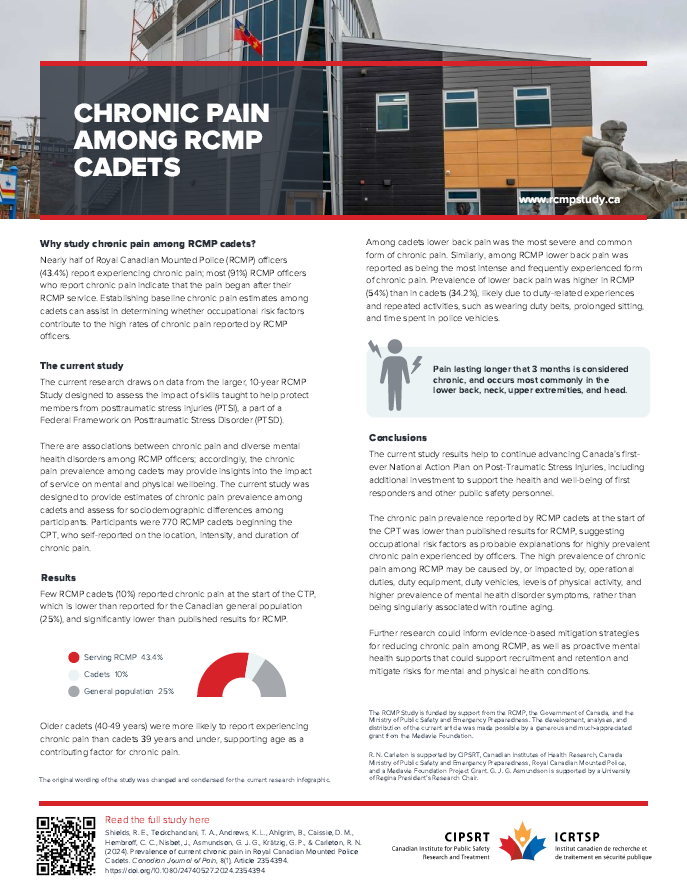Research Summaries
Why was the study done?
Nearly half of Royal Canadian Mounted Police (RCMP) officers (43.4%) report experiencing chronic pain; most (91%) RCMP officers who report chronic pain indicate that the pain began after their RCMP service. No study to date has provided baseline data on the prevalence of chronic pain among RCMP cadets beginning the Cadet Training Program (CTP). Establishing baseline chronic pain estimates among cadets can assist in determining whether occupational risk factors contribute to the high rates of chronic pain reported by active duty RCMP officers. There are associations between chronic pain and diverse mental health disorders among RCMP officers; accordingly, chronic pain prevalence among cadets may provide insights into the impact of service on mental and physical wellbeing.
What was done in the study?
The current research is part of a larger RCMP Study designed to assess the impact of skills taught to help protect members from posttraumatic stress injuries (PTSI). A research summary of the previously published RCMP Study Protocol is available online.
The current study was designed to provide estimates of chronic pain prevalence among cadets and assess for sociodemographic differences among participants. Participants were 770 RCMP cadets beginning the CPT, who self-reported on the location, intensity, and duration of chronic pain using the Chronic Pain Questionnaire.
What did we find out?
Few RCMP cadets (10%) reported chronic pain at the start of the CTP, which is lower than reported for the Canadian general population (1 in 4; or 25%), and lower than published results for RCMP. Cadets who reported chronic pain were 65.8% men. Women cadets reported greater intensity of lower back pain than men. Older cadets (40-49 years) were more likely to report experiencing chronic pain than cadets 39 years and under, supporting age as a contributing factor for chronic pain. The current study did not fully examine the cause of reported chronic pain, but cadets reported perceiving the cause of their chronic pain as: related to active duty (13.2%), a work-related injury other than active duty (11.8%), an injury unrelated to work (28.9%), or being unsure of the cause (18.4%). The data were collected at the start of the CTP; therefore, the cadets who reported work- or active-duty-related pain were referring to service outside the RCMP. Cadets with previous experience serving as public safety personnel (PSP) were no more likely than cadets without such previous experience to report chronic pain.
Among cadets, lower back pain was the most severe and common form of chronic pain. Similarly, among RCMP, lower back pain was reported as being the most intense and frequently experienced form of chronic pain. Prevalence of lower back pain was higher in RCMP (54%) than in cadets (34.2%), likely due to duty-related experiences and repeated activities, such as wearing duty belts, prolonged sitting, and time spent in police vehicles.
Levels of physical activity may partly explain differences in chronic pain prevalence. Levels of physical activity can differ between cadets who must attain specific fitness standards, and RCMP for whom fitness can decline through years of service due to several occupational factors. Previous research has indicated that physical activity may reduce the risk of chronic pain.
Where do we go from here?
The current study results help to continue advancing Canada’s first-ever National Action Plan on Post-Traumatic Stress Injuries, including additional investment to support the health and well-being of first responders and other public safety personnel.
The chronic pain prevalence reported by RCMP cadets at the start of the CPT was lower than published results for RCMP, suggesting occupational risk factors as probable explanations for highly prevalent chronic pain experienced by officers. The high prevalence of chronic pain among RCMP may be caused by, or impacted by, operational duties, duty equipment, duty vehicles, levels of physical activity, and higher prevalence of mental health disorder symptoms (a chronic pain comorbidity), rather than being singularly associated with routine aging. Further research could inform evidence-based mitigation strategies for reducing chronic pain among RCMP, as well as proactive mental health supports that could support recruitment and retention and mitigate risks for mental and physical health conditions.
The RCMP Study is funded by support from the RCMP, the Government of Canada, and the Ministry of Public Safety and Emergency Preparedness. The development, analyses, and distribution of the current article was made possible by a generous and much-appreciated grant from the Medavie Foundation.
R. N. Carleton is supported by CIPSRT, Canadian Institutes of Health Research, Canada Ministry of Public Safety and Emergency Preparedness, Royal Canadian Mounted Police, and a Medavie Foundation Project Grant. G. J. G. Asmundson is supported by a University of Regina President’s Research Chair.
The original wording of the study was changed and condensed for the current research summary.
Original study
Shields, R. E., Teckchandani, T. A., Andrews, K. L., Ahlgrim, B., Caissie, D. M., Hembroff, C. C., Nisbet, J., Asmundson, G. J. G., Krätzig, G. P., & Carleton, R. N. (2024). Prevalence of current chronic pain in Royal Canadian Mounted Police cadets. Canadian Journal of Pain, 8(1), Article 2354394. https://doi.org/10.1080/24740527.2024.2354394
Prepared by K. Vincent
